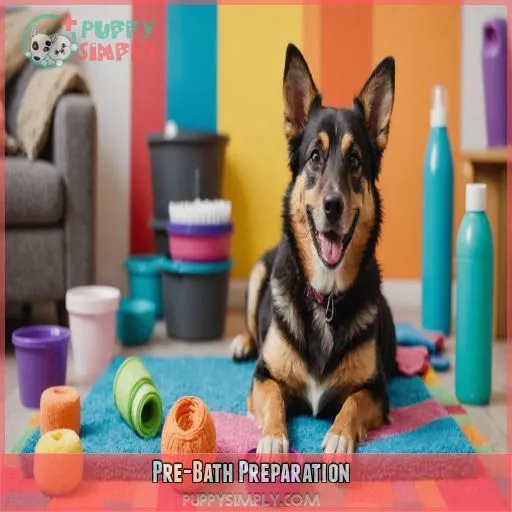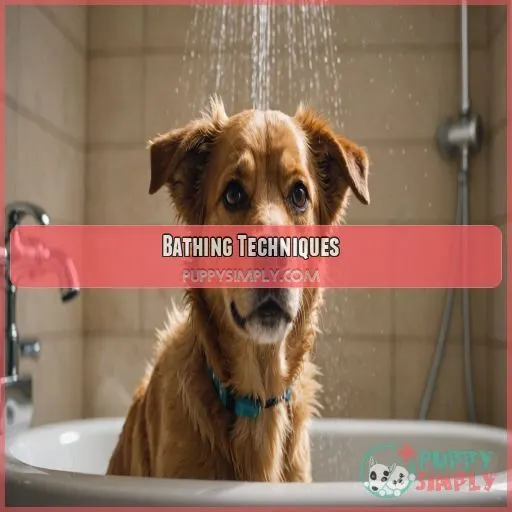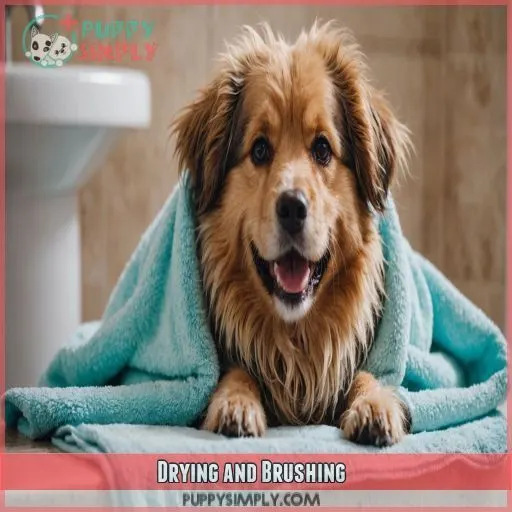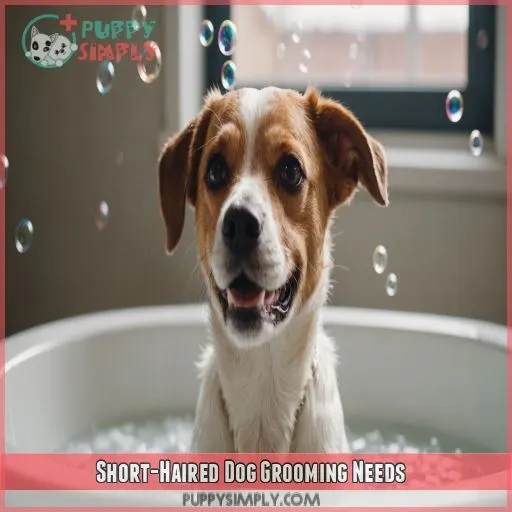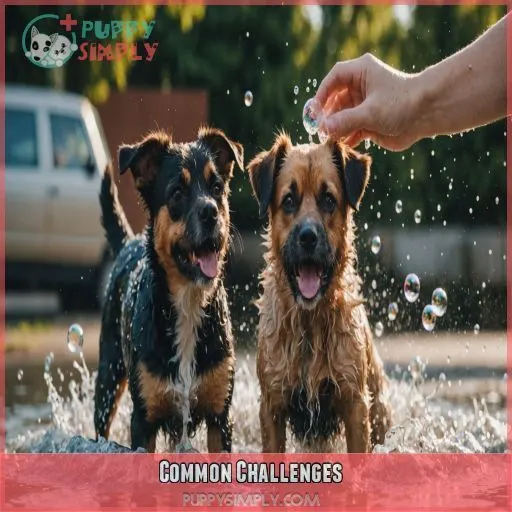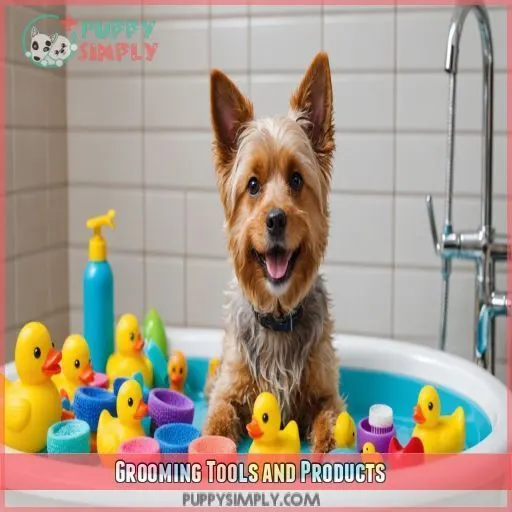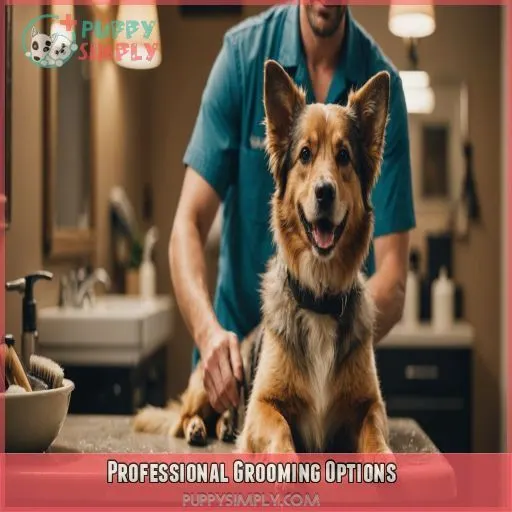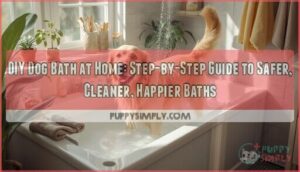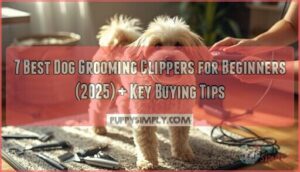This site is supported by our readers. We may earn a commission, at no cost to you, if you purchase through links.

First, brush them thoroughly to prevent mats and knots – a slicker or bristle brush is perfect for short-haired dogs.
Fill the tub with lukewarm water, add a non-slip mat, and protect those adorable ears with cotton balls.
Choose a pH-balanced, hypoallergenic shampoo, and massage it in from head to tail. Rinse thoroughly, and gently pat dry with a microfiber towel.
With these simple steps, you’ll be a pro at dog washing and bathing for dogs with short fur in no time – and your pup will thank you!
Table Of Contents
- Key Takeaways
- Pre-Bath Preparation
- Bathing Techniques
- Drying and Brushing
- Short-Haired Dog Grooming Needs
- Brushing and Combing
- Common Challenges
- Grooming Tools and Products
- Professional Grooming Options
- Frequently Asked Questions (FAQs)
- What do groomers do for short hair dogs?
- How often should a short-haired dog be bathed?
- How to stop a dog from shedding short hair?
- What is the best way to give a small dog a bath?
- How often should I bathe my short-haired dog outside?
- Can I use baby shampoo on my short-haired dog?
- Why do short-haired dogs shake after a bath so much?
- How can I reduce shedding for my short-haired dog breed?
- Can I use a hair dryer on my short-haired dog daily?
- Conclusion
Key Takeaways
- Before the bath, brush your short-furred friend thoroughly with a slicker or bristle brush to prevent mats and knots, and choose the right shampoo—a pH-balanced, hypoallergenic one that’s gentle on their skin.
- When bathing, fill the tub with lukewarm water, add a non-slip mat, and protect those adorable ears with cotton balls—and don’t forget to rinse thoroughly to remove all soap residue!
- After the bath, gently pat your short-haired dog dry with a microfiber towel, then let air drying do its magic—avoid hot temperatures and rubbing, as this can irritate their skin and cause moisture retention issues.
- To keep your short-furred friend’s coat healthy and shiny, brush them daily with a stiff-bristle brush or a slicker brush, and consider using a de-shedding tool during shedding season—and don’t forget to trim those nails and clean those ears regularly!
Pre-Bath Preparation
As you get ready to bathe your short-furred dog, it’s important to prepare them properly to make the experience enjoyable and stress-free for both of you. Before the bath, take a few minutes to brush and detangle their coat, set up safety precautions, and choose the right shampoo to help make bath time smooth and effective .
Brushing and Detangling
Before bathing your short-haired dog, brush and detangle their coat to prevent mats and knots. Here are three essentials to get you started:
- Choose the right brush: Use a slicker or bristle brush for short-haired dogs.
- Detangle gently: Work from head to tail, being gentle on sensitive areas.
- Remove loose hair: Regular brushing helps control shedding and prevents matting.
Safety Precautions for Bath Time
Now that you’ve brushed and detangled your short-furred friend, it’s time for bath safety 101. Fill the tub with lukewarm water, and add a non-slip mat to prevent slippery surfaces. Protect those adorable ears with cotton balls and avoid getting water in their eyes to make the bath as stress-free as possible.
Choosing the Right Shampoo
Now that you’ve got safety precautions covered, it’s time to choose the right shampoo for your short-furred friend. Opt for a natural, pH-balanced, hypoallergenic, and tearless pet shampoo that’s fragrance-free. This will help keep your dog’s coat healthy and make bath time a breeze.
Bathing Techniques
When it comes to bathing your short-haired dog, getting the technique right can make all the difference. A good bath can be a relaxing experience for both you and your pup. Learning how to lather, rinse, and avoid sensitive areas will help you give your dog a clean, healthy coat.
Lathering and Rinsing
Time to get your pup squeaky clean! Lathering and rinsing is a breeze with the right techniques. Here’s how:
- Wet your dog thoroughly with lukewarm water to prevent shampoo from sticking to their coat.
- Apply a small amount of shampoo and work it into a lather.
- Massage the lather into your dog’s coat, working from head to tail.
- Rinse thoroughly to remove all soap residue, ensuring a clean and healthy coat.
Avoiding Sensitive Areas
As you bathe your short-furred dog, remember to steer clear of sensitive areas like the eyes, ears, nose, and mouth. Be gentle around the paws and anal area too. Protect those adorable dog ears with cotton balls, and you’ll be a pro at keeping your pet clean and comfortable!
Tips for Bathing Small Dogs
When bathing small dogs, use gentle methods to avoid stressing them out. Opt for a small dog shampoo and avoid getting water in sensitive areas like ears and eyes. Keep baths short, around 5-10 minutes, and consider using a dog dryer on a low setting to prevent shivering.
Drying and Brushing
You’ve survived the bathing process, and now it’s time to dry and brush your short-haired dog – the final stretch of the grooming process. Proper drying and brushing techniques will help prevent shedding and matting, keep your dog’s coat healthy and shiny, and even strengthen the bond between you and your furry friend (Source).
Towel Drying and Air Drying
The bath is over, and it’s time to dry your short-furred friend. Gently pat them with a microfiber towel, then let air drying do its magic. Avoid hot temperatures and rubbing, as this can irritate their skin and cause moisture retention issues.
- Dry, don’t rub: Be gentle when towel drying to prevent skin irritation.
- Air dry, don’t overheat: Keep the air drying temperature comfortable to avoid moisture retention issues.
- Microfiber magic: Choose the right towel material to reduce friction and prevent pet discomfort.
Brushing for a Healthy Coat
Now that you’ve towel dried your short-furred friend, it’s time to brush them for a healthy coat! Use a stiff-bristle brush or a slicker brush daily to remove dead hair and distribute oils. Brushing regularly will keep their coat shiny, healthy, and looking its absolute best.
Preventing Shedding and Matting
Now that you’ve towel-dried and brushed your short-furred friend, let’s tackle shedding and matting. Use Furminator tools or shedding rakes to gently remove loose hair. For stubborn mats, grab a mat breaker or detangling spray. Regular grooming sessions will keep your dog’s coat healthy and your sanity intact!
Short-Haired Dog Grooming Needs
You’re probably wondering how often to bathe your short-haired dog and what other grooming needs they require. As a short-haired dog owner, you need to strike the right balance between keeping your furry friend clean and not over-bathing them, while also paying attention to their nail care, skin, and ear health.
Frequency of Bathing
For short-haired dogs, less is often more in terms of bathing. Aim for a bathing schedule of every 2-3 months, or as needed. Over-bathing can strip their coat of natural oils, while under-bathing can lead to skin issues and unpleasant odors.
Trimming and Nail Care
Now that we’ve covered bathing frequency, let’s tackle trimming and nail care. Use scissors or clippers specifically designed for dogs to trim excess fur, and grind nails with a nail grinder to prevent overgrowth. Don’t forget to check paw pads for cracks and moisturize as needed.
Skin and Ear Care
If you’ve got a short-haired dog, you’re the first line of defense against skin allergies, ear infections, and dry skin. Regular ear cleaning with the right grooming tools and checking for signs of trouble will keep your furry friend happy and healthy.
Brushing and Combing
Brushing and combing are really important steps to prevent matting and tangling.
They also remove loose hair and distribute skin oils for a healthy coat.
By choosing the right brush and establishing a daily brushing routine, you’ll make bath time easier.
You’ll also strengthen the bond with your dog and keep their coat looking its best.
Choosing the Right Brush
Time to get brush-savvy! For short-haired dogs, choose a stiff-bristle brush that’s gentle yet effective. Consider a brush with tightly-packed bristles for removing dead hair. Your dog’s coat length, fur type, and size will guide your brush selection – so pick wisely!
Daily Brushing Routine
Get ready for a daily date with your short-furred friend! Brush them daily to control shedding, promote coat health, and strengthen your bond. Choose a stiff bristle brush or a slicker brush, and gently work from head to tail, being gentle on sensitive areas.
De-Shedding and Matting
You’ve got your daily brushing routine down, now let’s tackle de-shedding and matting. Here are three essential tips to keep your short-furred friend’s coat in check:
- Invest in a de-shedding tool to reduce shedding and prevent hairballs.
- Use a slicker brush to gently work out mats and tangles.
- Brush more frequently during shedding season to keep your dog’s coat healthy and looking its best.
Common Challenges
Bathing your short-furred dog can be a bit of a challenge, and it’s easy for things to get messy for both you and your pup. From shedding and hair loss to skin irritations and those pesky fleas and ticks, knowing how to deal with these issues will make all the difference in keeping your dog clean, happy, and healthy.
Shedding and Hair Loss
Don’t panic about shedding and hair loss! It’s normal, especially during seasonal changes. Different breeds shed at varying rates, and diet plays a role too. Use the right grooming tools, like a de-shedding brush, to keep things under control and reduce the hair-raising chaos.
Skin Irritations and Allergies
Dealing with skin irritations and allergies can be a real pain – for both you and your short-furred friend. Identifying triggers is key, so keep an eye out for common allergens like pollen, dust, or certain foods. Consult your vet for proper diagnosis and treatment.
- Home remedies like oatmeal baths or aloe vera gel can provide temporary relief
- Allergy testing can help pinpoint specific culprits
- Consult your vet before making any significant changes to your dog’s diet or environment
Fleas and Ticks
Now that we’ve tackled skin irritations, let’s talk about those pesky fleas and ticks. To prevent infestations, use natural remedies like diatomaceous earth or essential oils in your yard treatment. Regularly inspect your dog for signs of fleas and ticks, and learn proper tick removal techniques.
Grooming Tools and Products
For a short-haired dog, having the right tools and products can make all the difference between a stressful bath time and a relaxing one. You’ll want to stock up on gentle shampoos and conditioners, sturdy brushes and combs, and nail trimmers and grinders that’ll keep your pup’s claws in check.
Shampoos and Conditioners
Looking for the right shampoo and conditioner for your short-haired pup? You’ve got options! Choose from natural, organic, tearless, medicated, or hypoallergenic formulas. Think about your dog’s skin type and needs. Here are some tips to get you started:
- Opt for a gentle, pH-balanced shampoo to avoid skin irritation.
- Use a conditioner to keep your dog’s coat moisturized and shiny.
- Consider a shampoo with a built-in flea and tick repellent for added protection.
Brushes and Combs
Now that you’ve got the right shampoo, let’s talk brushes and combs! For short-haired dogs, use a stiff-bristle brush or a slicker brush to remove dead hair. Choose a curry comb for gentle exfoliation and a de-shedding tool during shedding season. Brush care is key, so clean those brushes regularly!
Nail Trimmers and Grinders
Now that you’ve got the right brushes and combs, let’s tackle those nails! Choose a nail trimmer or grinder that suits your dog’s nail type. Remember, grinder safety is key – start slow and gentle to avoid overwhelming your pup. Nail trimming is a breeze with the right tools!
Professional Grooming Options
As a short-haired dog owner, you might wonder if professional grooming is really necessary for your low-maintenance pup. But, having a pro on board can be a game-changer, helping you tackle tricky tasks like nail trimming, ear cleaning, and coat conditioning, all while giving you personalized tips and tricks to keep your furry friend looking and feeling their best.
Finding a Professional Groomer
When finding a professional groomer, ask for recommendations, check online reviews and ratings, and compare costs and fees. Schedule a meet-and-greet to make sure you and your dog get along with the groomer. Also, verify their qualifications and experience with short-haired breeds. Your dog’s comfort is key!
Benefits of Regular Grooming
Regular grooming sessions with a pro can be a game-changer! You’ll enjoy reduced shedding, healthier skin, and a stronger bond with your dog. Plus, early detection of potential issues and fewer allergies are just a few more benefits to look forward to.
Cost and Frequency of Grooming Sessions
In the context of professional grooming sessions, costs and frequency vary. Session length, groomer rates, and package deals all impact the final bill. Add-on services, like nail trimming, and mobile grooming costs can add up. Expect to pay anywhere from $30 to $90 per session, depending on your dog’s needs.
Frequently Asked Questions (FAQs)
What do groomers do for short hair dogs?
Back in the Wild West of dog grooming, you’d think short-haired dogs get off scot-free, but not quite, partner! As a groomer, you’ll focus on nail trims, ear cleanings, and brushing to distribute oils for a healthy coat.
How often should a short-haired dog be bathed?
You’re wondering how often to bathe your short-haired dog. The good news is, they typically need fewer baths than their long-haired friends.
Aim for a bath every 1-2 weeks, or as needed, to keep them clean and fresh.
Bathing your short-haired dog too often can strip their coat of its natural oils. Aim for a bath every 4-6 weeks, or as needed.
You can also spot clean them in between baths to keep them fresh and clean.
How to stop a dog from shedding short hair?
You can reduce your dog’s shedding by brushing them daily with a stiff bristle brush or a de-shedding tool. Regular baths and using a deshedding shampoo can also help. Consider a humidifier to keep their skin moist.
What is the best way to give a small dog a bath?
Bathing your small dog is like conducting a symphony – it requires harmony and precision! Brush them gently, use lukewarm water and a vet-approved shampoo, and rinse thoroughly to keep your furry friend squeaky clean and happy.
How often should I bathe my short-haired dog outside?
Can I use baby shampoo on my short-haired dog?
Don’t risk it! Baby shampoo can be too harsh for your short-haired dog’s skin. Instead, use a vet-approved, gentle dog shampoo to keep their coat clean and healthy. Your furry friend’s skin will thank you!
Why do short-haired dogs shake after a bath so much?
Your short-haired dog shakes after a bath due to cold water, stress, or relief. To minimize this, use lukewarm water, gentle shampoo, and calm energy. Keep them warm and comforted post-bath, and they’ll thank you.
They might also shake to dry off and regulate their body temperature. This is a natural response to help them get warm and cozy again.
You’re wondering why your short-haired dog is shaking like crazy after a bath. It’s likely due to cold water, anxiety, or pent-up energy. Try using lukewarm water and providing a warm, comfy space to calm them down.
To make bath time more comfortable for your dog, use warm water, dry them thoroughly, and provide a cozy environment. This will help reduce shaking and make the experience more enjoyable for both of you.
How can I reduce shedding for my short-haired dog breed?
To reduce shedding for your short-haired dog, brush them daily with a stiff bristle brush, like Chris Christensen’s Original Ionic Brass Boar Brush, and bathe them weekly with a gentle dog shampoo and conditioner.
Can I use a hair dryer on my short-haired dog daily?
Sorry buddy, it’s best not to use a hair dryer on your short-haired dog daily, as they can easily get burns due to their thin coats. Instead, gently towel dry or air dry them to keep their skin safe.
Conclusion
Dog washing and bathing for dogs with short fur requires harmony between preparation, technique, and patience.
You’ve learned the essential grooming tips to make bath time a breeze for your short-furred friend.
By following these simple steps, you’ll be a pro at dog washing and bathing for dogs with short fur in no time.
With practice, you’ll find the perfect rhythm to keep your pup clean, happy, and healthy.

